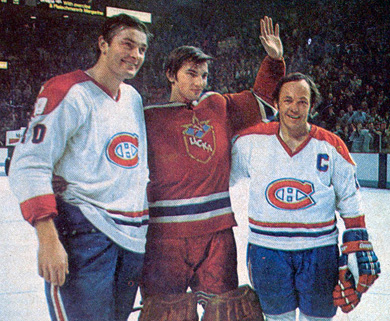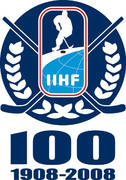

Story #23 Montreal and CSKA play an epic 3-3 game on New Year’s EveDecember 31, 1975 — Montreal, Canada
The shots on goal said so much and so little at the same time. The game summary from what is now simply called the “New Year’s Eve game” of 1975 showed the Montreal Canadiens with 38 shots and CSKA Moscow with 13. Yet, the score was 3-3, and this was a figure that held so much more meaning. The shots weren’t representative of any overwhelming margin of play by the Canadiens. Instead, they reflected two radically different systems of play. Montreal was like any other NHL team. Players moved the puck toward the goal, and when they got a chance they fired the puck on net. “Any shot is a good shot,” is the NHL motto. The Soviets were not so cavalier. They circled and passed, moving in a tornado of motion toward the enemy net, and only when a player had a clear and distinct scoring chance did he dare risk losing possession of the puck by taking a shot. To simply fire the puck at random, hoping for a goal, was a waste of possession, a wasted opportunity, in the eyes of the Soviet system.  Steve Shutt scored with a heavy slapshot early in the game to give the 18,975 fans something to cheer about, and a few minutes later, Yvon Lambert made it 2-0. It wasn’t until midway through the period that the Soviets registered their first shot on goal, and it wasn’t until 3:54 of the second period that they got back into the game. Mikhailov let go a tremendous wrist shot from the high point that beat Dryden over the glove, but Yvan Cournoyer extended the lead to two goals again midway through the period. Kharlamov gave the Soviets life later in the second with an amazing individual effort, and then Boris Alexandrov tied the game at 4:04 of the third just a short time after Tretiak robbed Lemaire from in close. Despite Montreal’s heavy outshooting of their opponents, it was CSKA who came closest to a winning goal in the third period when little known forward Popov hit the post on a clean breakaway.  Montrealer Mike Boon, today a reporter for the Montreal Gazette, wrote that “getting tickets and being able to see the game was the second biggest things that happened in my life after becoming father.” The game made such an impression on a Russian artist that he produced a series of 18 paintings interpreting the game. About the Top 100 StoriesAs part of the IIHF's 100th anniversary celebrations, www.IIHF.com is featuring the 100 top international hockey stories from the past century (1908-2008). Starting now and continuing through the 2008 IIHF World Championships in Canada, we will bring you approximately three stories a week counting down from Number 100 to Number 11.
The Final Top 10 Countdown will be one of the highlights of the IIHF's Centennial Gala Evening in Quebec City on May 17, the day prior to the Gold Medal Game of the 2008 World Championship.
These are the criteria for inclusion on this list: First, the story has to have had a considerable influence on international hockey. Second, it has to have had either a major immediate impact or a long-lasting significance on the game. Third, although it doesn't necessarily have to be about top players, the story does have to pertain to the highest level of play, notably Olympics, World Championships, and the like. The story can be about a single moment — a goal, a great save, a referee's call — or about an historic event of longer duration — a game, series, tournament, or rule change. |
 Click here for the 100 Top Stories
|
|






